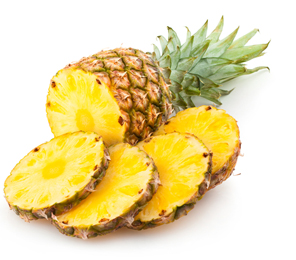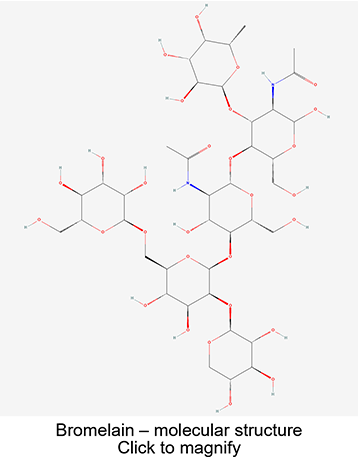The pineapple

The pineapple (Ananas comosus) is a tropical plant with an edible fruit; it is the most economically significant plant in the family Bromeliaceae.
The pineapple is indigenous to South America, where it has been cultivated for many centuries. The introduction of the pineapple plant to Europe in the 17th century made it a significant cultural icon of luxury. Since the 1820s, pineapple has been commercially grown in greenhouses and many tropical plantations.
Pineapples grow as a small shrub; the individual flowers of the unpollinated plant fuse to form a multiple fruit. The plant normally propagates from the offset produced at the top of the fruit or from a side shoot, and typically matures within a year.
Pineapple – food plant
Pineapple is highly valued for its excellent taste. It provides large, juicy and aromatic fruits, suitable for consumption both raw and processed (juices, jams, compotes).
Nutritional values of pineapple per 100 g: energy value is 235 kJ and 55 kcal. Water is 85.5 g of the fruit content. Proteins constitute 0.4 g and fats 0.2 g (0.01 g each of palmitic and stearic acid; 0.02 g of oleic acid; 0.04 g of linolenic acid and 0.03 g of α-linolenic acid). Pineapple has a high glycemic index: 59. Minerals and vitamins per 100 g: sodium - 1 mg; potassium - 22 mg; calcium - 17 mg; phosphorus - 12 mg; magnesium - 15 mg; iron - 0.3 mg; zinc - 0.24 mg; copper - 0.07 mg; manganese - 0.5 mg; iodine - 0.2 mg, vitamin A - 7 µg; β-carotene - 42 µg; vitamin E - 0.1 mg; thiamine - 0.09 mg; riboflavin - 0.04 mg; niacin - 0.4 mg; vitamin B6 - 0.09 mg; folates - 11 µg; vitamin C - 15 mg.
Pineapple – a medicinal plant
Bromelain is obtained by extraction from pineapple fruit and stems. Bromelain is a proteolytic enzyme system composed of at least 5 enzymes with different molecular weights and different molecular structures. In addition, some bromelains also contain phosphatase, peroxidase, cellulase, glycosidase and non-protein substances. Bromelain is a glycoprotein whose molecular structure contains an oligosaccharide consisting of xylose, fucose, mannose and N-acetylglucosamine. Bromelain has multidirectional therapeutic effects, which have been confirmed in clinical trials.
Since the presented product is a dietary supplement, it is not allowed to attribute therapeutic properties to it, so it is worth reading the article posted on the Biotechnology Research International website → "Properties and Therapeutic Application of Bromelain: A Review".
In addition, bromelain may enhance the effect of antibiotics, so you need to be careful when taking medications. Bromelain is also one of the main pineapple allergens. Unripe pineapple can irritate the throat and cause diarrhea.
References:
- Azizan A, Lee AX, et al: Potentially Bioactive Metabolites from Pineapple Waste Extracts and Their Antioxidant and α-Glucosidase Inhibitory Activities by H NMR Foods; 2020, 9, 173.
- Xi-Hua L, De-Quan S. et al: Physico-Chemical Properties, Antioxidant Activity and Mineral Contents of Pineapple Genotypes Grown in China; Molecules. 2014 Jun; 19(6): 8518–8532.







